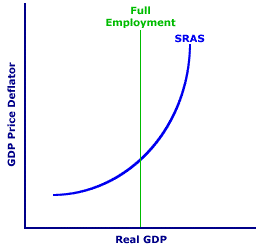The positive slope of the short-run aggregate supply curve, reflecting the direct relation between the price level and real production, results for three primary reasons--inflexible resources, frictional and structural unemployment, and purchasing power imbalances.The short-run aggregate supply (SRAS) curve graphically represents the direct relation between the price level and aggregate real production. A higher price level is related to more real production and a lower price level is related to less real production. That is, the business sector is inclined to offer more total goods and services for sale if the price level rises and less if the price level falls.
The key question is: Why? Why does the short-run aggregate supply curve have a positive slope? While the general reason is similar to that of market supply curves--the opportunity cost of production--three specific reasons are at work:
- Inflexible resource prices that often makes it easier to reduce aggregate real production and resource employment when the price level falls.
- The pool of natural unemployment, consisting of frictional and structural unemployment, that can be used temporarily to increase aggregate real production when the price level rises
- Imbalances in the purchasing power of resource prices that can temporarily entice resource owners to produce more or less aggregate real production than they would at full employment.
| The SRAS Curve |
|---|
 |
Note that the green vertical line in this graph designates the full employment level of real production.
- With a higher price level, the economy can supply real production that exceeds the full employment level. Click the [Higher Price Level] button to illustrate this point.
- With a lower price level, the economy can supply real production that is less than this full employment level. Click the [Lower Price Level] button to illustrate this point.
Opportunity Cost of Production
While the specific mechanism of moving along the short-run aggregate supply curve is more complex, the basic source of the short-run aggregate supply curve's positive is very similar to that for the standard market supply curves--the opportunity cost of production. For market supply, increased production of a good is associated with a greater opportunity cost of production, and thus supply price. Decreased production is related to a lower opportunity cost of production and supply price. The underlying reason for this direct relation between supply price and quantity supplied for market supply can be found in the law of diminishing marginal returns.
The positive slope of the short-run aggregate supply curve and the direct relation between price level and aggregate real production is also generally attributable to the opportunity cost of production. That is, an increase in the aggregate real production by the business sector in the short run involves a greater overall opportunity cost of production and thus price level. A decrease in aggregate real production is related to lower opportunity cost and price level. In other words, larger quantities of aggregate real production carry a higher price level because the opportunity cost of production is also greater.
Inflexible Resource Prices
By definition, the short run is a period in which some prices, particular resource prices, are inflexible. This inflexibility prevents resource markets from eliminating shortages and surpluses and achieving equilibrium. In other words, workers' wages do not decline even when unemployment rises. Inflexible resource prices, especially wages, are most important when the price level and real production decline. Faced with falling economic activity, resource employment and real production tend to fall first, bearing the brunt of the reduction, while resource prices remain relatively unchanged.
Suppose, for example, that The Wacky Willy Company, which manufactures Wacky Willy Stuffed Amigos (those cute and cuddly armadillos and turtles) faces falling demand reflected by a lower price that buyers are willing to pay. With less revenue, The Wacky Willy Company needs to cut production cost. In the short run, it is likely to do so by reducing production and resource employment rather than resource prices.
- One reason is that The Wacky Willy Company has multi-year contracts with its workforce and other resources. They CANNOT reduce resource prices without renegotiating these contracts.
- Another reason is that Wacky Willy workers view their wages as an indication of intrinsic self-worth. Even if The Wacky Willy Company can pay workers less, many would opt for temporary unemployment instead as they search for other jobs at the same pay.
- A third reason is that the process involved in laying off a few workers is often easier than reducing the wages for every worker on the payroll. It is a costly procedure for The Wacky Willy Company to update its computer payroll system with different wages for every employee.
Natural Unemployment
Natural unemployment consists of frictional and structural unemployment.- Frictional unemployment results because it takes time for employers and workers to find one another.
- Structural employment results because the skills needed by employers do not match the skills possessed by the workers.
However, both frictional and structural unemployment can be reduced temporarily. And when they are reduced, the economy's total employment and aggregate real production increase. This pool of natural employment provides a means of increasing real production beyond full employment when the price level rises. A higher price level, brought about by expanding economic activity, entices firms and resource owners to incur the extra cost needed to reduce natural unemployment and increase real production.Once again, consider the operation of The Wacky Willy Company. When business is booming, like any firm, The Wacky Willy Company is prompted to expand production by increasing the quantities of resources used. In other words, they hire more workers and buy more of the other resources used. While they are not particularly concerned with the economy's full employment level of production, it affects their ability to acquire the resources needed to produce more Stuffed Amigos.